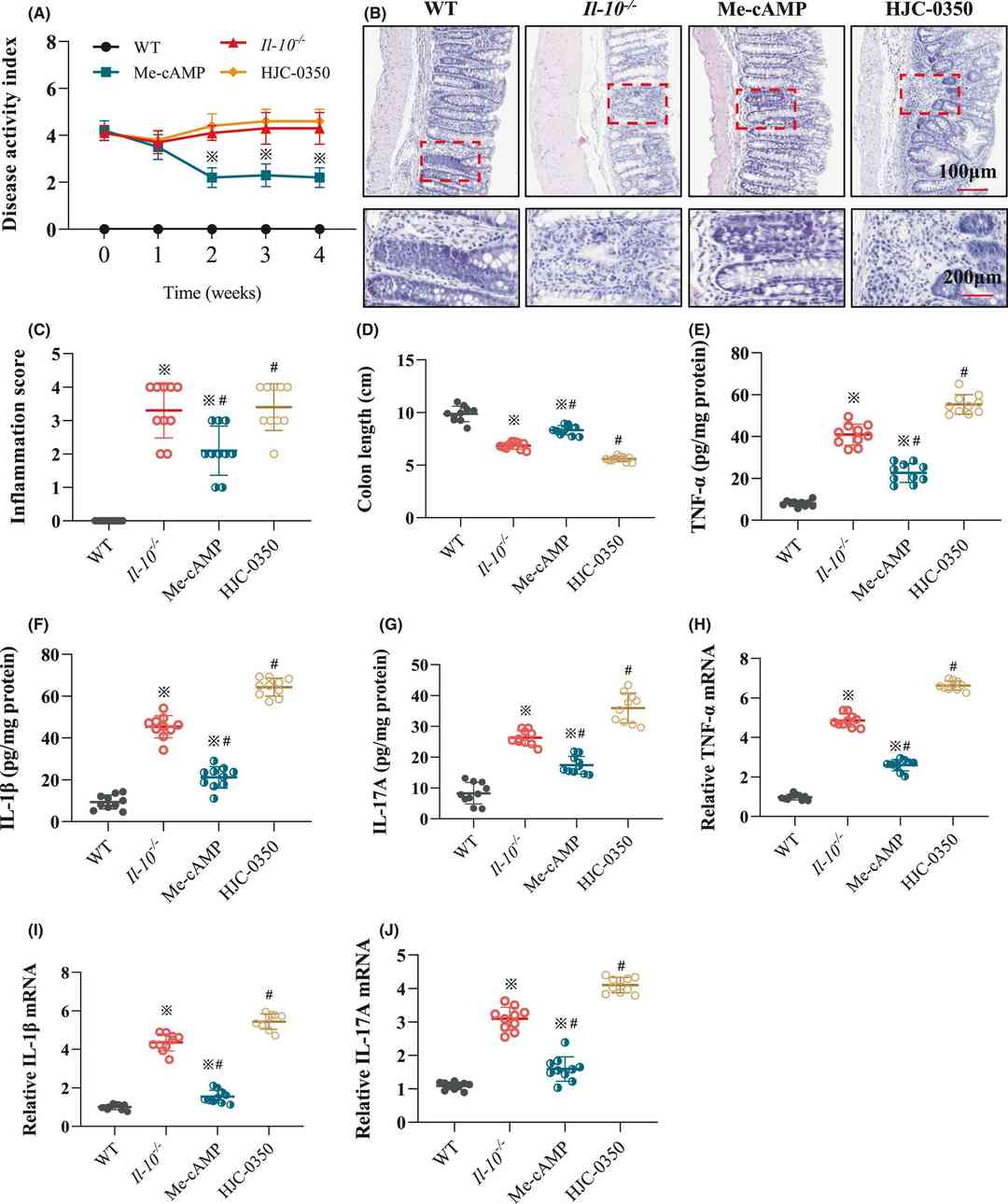- You are here: Home
- Disease Models
- Inflammation & Autoimmune Disease Models
- Inflammatory Bowel Disease Models
- IL-10 Knockout Colitis Model
Disease Models
- Oncology Models
-
Inflammation & Autoimmune Disease Models
- Rheumatoid Arthritis Models
- Glomerulonephritis Models
- Multiple Sclerosis (MS) Models
- Ocular Inflammation Models
- Sjögren's Syndrome Model
- LPS-induced Acute Lung Injury Model
- Peritonitis Models
- Passive Cutaneous Anaphylaxis Model
- Delayed-Type Hypersensitivity (DTH) Models
- Inflammatory Bowel Disease Models
- Systemic Lupus Erythematosus Animal Models
- Asthma Model
- Sepsis Model
- Psoriasis Model
- Atopic Dermatitis (AD) Model
- Scleroderma Model
- Gouty Arthritis Model
- Carrageenan-Induced Air Pouch Synovitis Model
- Carrageenan-Induced Paw Edema Model
- Experimental Autoimmune Myasthenia Gravis (EAMG) Model
-
Cardiovascular Disease Models
- Surgical Models
- Animal Models of Hypertension
- Venous Thrombosis Model
- Atherosclerosis model
- Cardiac Arrhythmia Model
- Hyperlipoidemia Model
- Doxorubicin-induced Heart Failure Model
- Isoproterenol-induced Heart Failure Model
- Arterial Thrombosis Model
- Pulmonary Arterial Hypertension (PAH) Models
- Heart Failure with Preserved Ejection Fraction (HFpEF) Model
-
Neurological Disease Models
- Alzheimer's Disease Modeling and Assays
- Seizure Models
- Parkinson's Disease Models
- Ischemic Stroke Models
- Acute Spinal Cord Injury (ASCI) Model
- Traumatic Brain Injury (TBI) Model
- Hypoxic-Ischemic Encephalopathy (HIE) Model
- Tourette Syndrome (TS) Model
- Amyotrophic Lateral Sclerosis (ALS) Model
- Huntington's Disease (HD) Model
- Intracerebral hemorrhage (ICH) Models
- Pain Models
- Metabolic Disease Models
- Liver Disease Models
- Rare Disease Models
- Respiratory Disease Models
- Digestive Disease Models
-
Urology Disease Models
- Cisplatin-induced Nephrotoxicity Model
- Unilateral Ureteral Obstruction Model
- 5/6 Nephrectomy Model
- Renal Ischemia-Reperfusion Injury (RIRI) Model
- Diabetic Nephropathy (DN) Models
- Passive Heymann Nephritis (PHN) Model
- Adenine-Induced Chronic Kidney Disease (CKD) Model
- Kidney Stone Model
- Doxorubicin-Induced Nephropathy Model
- Orthopedic Disease Models
- Ocular Disease Models
- Skin Disease Models
- Infectious Disease Models
IL-10 Knockout Colitis Model
Creative Bioarray has successfully developed the IL-10 Knockout Colitis Model, a highly relevant and extensively validated animal model that spontaneously develops inflammatory bowel disease (IBD). This model is characterized by abnormal weight gain or loss, decreased survival rates, heightened levels of inflammatory cytokines, pronounced intestinal inflammation, and distinct abnormalities in intestinal phenotypes. This model serves as an invaluable tool for researchers, enabling them to closely mimic human IBD conditions and thereby accurately evaluate the potential of new therapeutic agents.
IL-10 is crucial in the susceptibility to IBD, especially in patients with very early-onset IBD, where mutations in IL10 and its receptor are commonly found. The IL10 knockout mouse model, which mirrors human IBD symptoms, is widely used in research. This model features a Th1/Th17 immune response, epithelial hyperplasia, and other inflammatory markers, and it develops colitis spontaneously due to IL-23 and Th1-like inflammation, influenced by genetic background. Under specific pathogen-free (SPF) conditions, BALB/c IL10 KO mice exhibit early, severe disease with minimal variation, closely replicating human chronic colitis. These mice are essential for understanding IBD mechanisms and screening new drugs, proving invaluable in IBD research.
Our IL-10 Knockout Colitis Model
Animal Species
- BALB/c-IL-10 knockout mouse
Endpoints
- Body weight
- DAI score
- Colon weight
- Colon length
- qPCR or Western blot
- Histology analysis
- Other customized endpoints according to your specific needs
Example Data
 Fig. 1 Effect of Epac-2 on colitis in Il-10-/- mice. (A) The DAI scores of mice in the WT group, Il-10-/- group, Me-cAMP group and HJC-0350 group. (B) Haematoxylin and eosin (H&E) staining revealed the histological manifestations of colonic tissues in each group after 4 weeks of treatment. (C) The inflammatory scores revealed the values of intestinal tissues in each group after treatment. (D) The colon lengths of mice in each group were measured and recorded after treatment completion. (E-G) The protein levels of TNF-α, IL-1β and IL-17A in colons from mice in each group. (H-J) The mRNA levels of cytokines in colons from mice in each group. (Song et al. 2022)
Fig. 1 Effect of Epac-2 on colitis in Il-10-/- mice. (A) The DAI scores of mice in the WT group, Il-10-/- group, Me-cAMP group and HJC-0350 group. (B) Haematoxylin and eosin (H&E) staining revealed the histological manifestations of colonic tissues in each group after 4 weeks of treatment. (C) The inflammatory scores revealed the values of intestinal tissues in each group after treatment. (D) The colon lengths of mice in each group were measured and recorded after treatment completion. (E-G) The protein levels of TNF-α, IL-1β and IL-17A in colons from mice in each group. (H-J) The mRNA levels of cytokines in colons from mice in each group. (Song et al. 2022)
Quotation and Ordering
Creative Bioarray is recognized as a premier CRO for preclinical drug development. We assist in selecting the most validated and dependable models for testing your compounds. Furthermore, we collaborate with our clients to create new animal models that are customized to meet their unique pharmaceutical screening and evaluation needs. If you are interested in our services, please do not hesitate to contact us at any time or submit an inquiry to us directly.
Reference
- Song, X., et al. Epac-2 ameliorates spontaneous colitis in Il-10-/- mice by protecting the intestinal barrier and suppressing NF-κB/MAPK signaling. Journal of Cellular and Molecular Medicine, 2022, 26(1): 216-227.
For research use only. Not for any other purpose.

